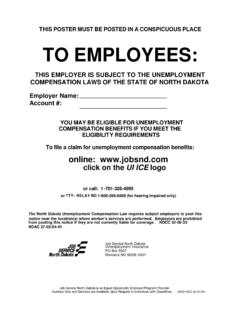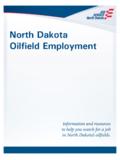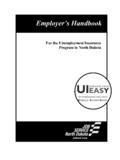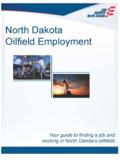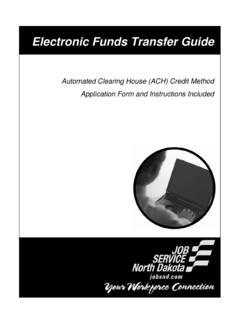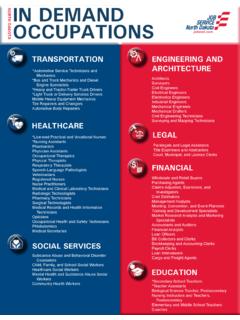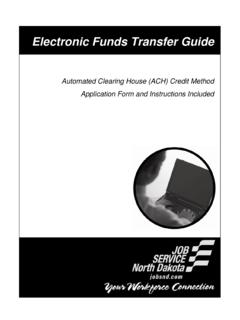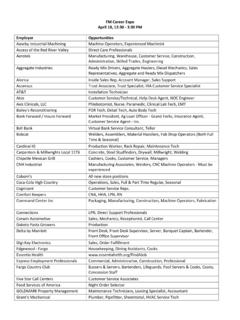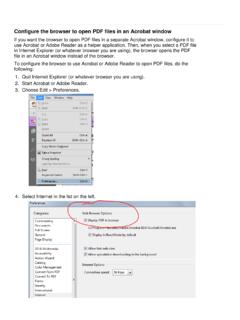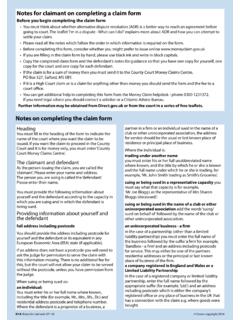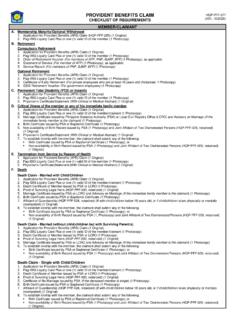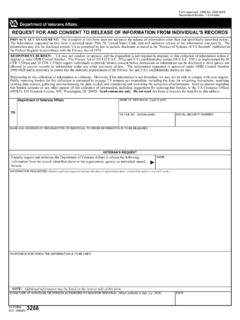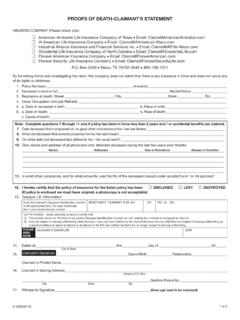Transcription of CLAIMANT GUIDE - Job Service North Dakota
1 U N E M P LOYM E N T. I N S U RA N C E. C L A IMANT. GUID E. TABLE OF CONTENTS. S E C T I O N A : Introduction to Unemployment Insurance Introduction Disclosure of Information What is Unemployment Insurance Who Pays for Unemployment Insurance Types of Unemployment Insurance Claims Equal Opportunity UI Glossary S E C T I O N B : Am I Eligible to Receive Unemployment Insurance? Monetary and Non-Monetary Eligibility Able to Work Available for Work Seeking Work S E C T I O N C : How to File a Claim Claim Filing Information How to Access Unemployment services Canceling a Claim Reopening a Claim S E C T I O N D : I Filed My Claim, Now What Do I Do? To-Do List Waiting Week Personal Identification Number (PIN). Weekly Certifications When to Certify Reporting Earnings 2. Unemployment Insurance CLAIMANT GUIDE Job Contacts Resume Reemployment services Returning to Work S E C T I O N E : How Much Will I Receive in Benefits? Monetary Requirements Base Period Unemployment Benefit Estimator Debit Card or Direct Deposit Payments Deductions from Weekly Benefit Payments Tax on Unemployment Insurance Benefits S E C T I O N F : What could keep me from receiving Unemployment Insurance?
2 Disqualifications S E C T I O N G : What if I do not agree with a Job Service decision? Appealing a Determination First Level Appeals Hearing Procedure Bureau Review S E C T I O N H : Audits, Overpayments and Fraud Audits of your Claim Penalty for Fraud Benefit Overpayments Repayment of Overpaid Benefits 3. Unemployment Insurance CLAIMANT GUIDE F O R M S. ES-935 Affidavit of Federal Civilian Service Wages ID Verification Form Job Contacts Record Medical Statement Retirement Benefits Request for Benefits While in Training 4. Unemployment Insurance CLAIMANT GUIDE INTRODUCTION TO. UNEMPLOYMENT INSURANCE. I N T R O D U C T I O N. This Unemployment Insurance CLAIMANT GUIDE provides an overview of the benefit provisions of the North Dakota unemployment compensation law. This GUIDE is not intended to be your sole source of unemployment insurance information, nor is it a substitute for the North Dakota unemployment compensation law. It is your responsibility to understand and follow the instructions provided in this GUIDE and to seek answers to questions you may have.
3 For more information and answers to specific questions visit , Unemployment for Individuals, then Resources-Unemployment for Individuals. This GUIDE provides instructions and directions on things like filing or reopening your claim, completing weekly certifications, and completing eligibility requirements. It also explains your rights and responsibilities under the North Dakota unemployment compensation law. Read this GUIDE carefully. You can only receive benefits if you meet all the outlined requirements. D I S C L O S U R E O F I N F O R M A T I O N. State law provides that information Job Service obtains from you and your employers shall be held confidential and not be open to public inspection or disclosure, except as authorized by law. This Disclosure of Information provision also applies to your spouse, friends, and relatives. If you have a question or problem with your unemployment insurance benefits claim, YOU are the only individual to whom Job Service North Dakota will provide any information concerning your claim.
4 5. Unemployment Insurance CLAIMANT GUIDE Notice: Confidential information collected from you as part of the unemployment insurance process may be requested and used for other governmental purposes, including, but not limited to, verification of eligibility under other government programs as required by law. W H A T I S U N E M P L O Y M E N T I N S U R A N C E ? Unemployment insurance is temporary financial assistance you may be eligible to receive if you become unemployed through no fault of your own (as determined by federal and state law) and you meet other eligibility requirements. Unemployment insurance is funded entirely by employers' unemployment insurance program tax contributions. It is intended to provide partial wage replacement while you search for a new job or return to work. W H O P A Y S F O R U N E M P L O Y M E N T I N S U R A N C E ? Unemployment insurance benefits are paid by employer premiums. No money is deducted from your paycheck to pay for Unemployment Insurance benefits.
5 Under the Federal Unemployment Tax Act of 1939, employers are required to pay premiums for the cost of Unemployment Insurance at the state and federal levels. T Y P E S O F U N E M P L O Y M E N T I N S U R A N C E C L A I M S. Combined Wage Claim If you worked in North Dakota and any other state(s) and choose to use all your wages, you may be able to combine your wages and file a claim in North Dakota or any of the other states in which you have wages. Unemployment compensation for Ex-Military Personnel (UCX). You may be entitled to unemployment insurance depending upon the length of your Service in the armed forces and the nature of your discharge. If you separated from the armed forces within the last two years you may be requested to submit a copy of your DD-214. 6. Unemployment Insurance CLAIMANT GUIDE Unemployment Compensation for Federal Employees (UCFE). If your unemployment insurance is based on your federal civilian wages, Job Service will receive reports from the federal agency verifying your status, wage records and official duty station.
6 On rare occasions, the federal agency may not provide information to Job Service in a timely manner. To ensure any payment due is made promptly, you may fill out the ES-935 CLAIMANT 's Affidavit of Federal Civilian Service Wages and Reason for Separation UCFE form located on Select unemployment for individuals, then Forms. Credible evidence such as your SF 50, Earnings and Leave Statement, and/or a W-2 must be submitted with your ES-935 form. To ensure the proper federal agency was contacted, please provide a copy of your Standard Form 8 (SF-8). Additional information and How To videos explaining the unemployment insurance requirements are available in the Resources Unemployment for Individuals section on 7. Unemployment Insurance CLAIMANT GUIDE AM I ELIGIBLE TO RECEIVE UNEMPLOYMENT. INSURANCE. MONETARY AND NON MONETARY ELIGIBILITY. You must meet the eligibility requirements set forth by the Unemployment Insurance Program to receive unemployment insurance benefits.
7 These conditions help ensure payments are only made to individuals eligible to receive benefits. There are 2 types of eligibility requirements that qualify you for the unemployment insurance program. 1) You must meet the monetary eligibility requirements. a. This tells you how much your weekly benefit will be and the number of weeks you qualify for. 2) You must also meet the non-monetary eligibility requirements. a. These include all other UI program requirements not associated with the weekly benefit amount and duration. Non-Monetary Determinations Throughout the duration of your claim, you may receive non-monetary determination letters. The non-monetary determination letter(s) will state whether unemployment insurance benefits will be allowed or denied on your claim. Even if you may have earned enough wages in your base period to qualify for unemployment insurance, you can be disqualified for other non-monetary reasons. BASIC E L I G I B I L I T Y R E Q U I R E M E N T: A B L E T O W O R K.
8 You must be physically able to work at the time you file your unemployment insurance claim. B A S I C E L I G I B I L I T Y R E Q U I R E M E N T: A V A I L A B L E F O R W O R K. You must be available for recall at the employer's request if you are returning to the employer that laid you off. If you are not returning to the employer that laid you off, and/ or you are required to search for work and make job contacts, you must be immediately available to accept any work suitable to your training, experience, and capabilities. 9. Unemployment Insurance CLAIMANT GUIDE Being available for work is an important part of receiving unemployment insurance benefits. You are not considered to be available for work and therefore not eligible to receive benefits if such things as lack of transportation or lack of child care prevent you from being able to take a job. You must also be willing to accept suitable employment for which you are qualified. You are not eligible to receive benefits for any time you are out of the area on vacation or personal business, unless your time away is for job search reasons.
9 It is not necessary to call if you plan to be away from home on weekends or if you are available to immediately accept work. BASIC E L I G I B I L I T Y R E Q U I R E M E N T: S E A R C H F O R W O R K. You must actively search for work if you are not returning to the employer who laid you off and/or if you are required to search for work and make job contacts. This is required for each week you wish to receive benefits including your waiting week. Begin making your job contacts the same week that you apply for benefits. The purpose of a job contact is to become employed. Additional information and How To videos explaining the unemployment insurance requirements are available in the Resources Unemployment for Individuals section on 10. Unemployment Insurance CLAIMANT GUIDE HOW TO FILE A CLAIM. CLAIM FILING INFORMATION. You must file a new claim or reopen an existing claim online at or by calling the automated phone system to receive unemployment insurance benefits.
10 Your claim is effective the Sunday of the week in which you file your claim. Job Service cannot backdate your claim. Your unemployment insurance benefit claim is good for one year based on the effective date of your claim. This 52-week period is called your benefit year. Once your benefits are exhausted for your benefit year, you must wait until the end of your benefit year before you can file a new claim in North Dakota . If you exhaust your North Dakota benefits and have earnings in another state, you may be eligible to file a claim in that state. If you have not used all the benefits in your benefit year and return to work, you can reopen your claim within the benefit year. Job Service will ask you and your employer(s) questions concerning the reason you are no longer employed to determine if you are eligible to receive benefits. The time this eligibility process takes varies and depends on the circumstances of your separation. Job Service must allow all parties involved appropriate time to respond to the questions asked of them.

